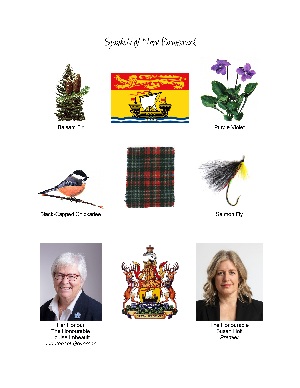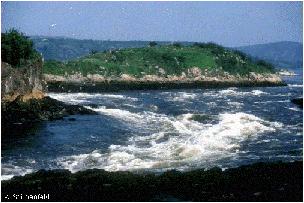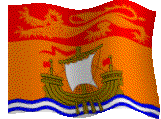- Capital
- Fredericton
- Other major cities
- Moncton, Saint John
- Date Entered the Federation
- July 1, 1867
- Provincial Flower
- Purple Violet
- Provincial Bird
- Black-capped Chickadee
- Motto
- Spem Reduxit
- "Hope was restored"
- Official Languages
- English and French
- Population
- 825,474 (2023)
- Area
- 72,908 sq km
- Lieutenant Governor
- Her Honour The Honourable Brenda Murphy
- Premier
- The Honourable Blaine Higgs (Progressive Conservative Party)
|

|
Click on the picture for free downloads
including this image. |
|
Of the total population, 64% gave their mother tongue as English and 32.7% French in the census of 1991. Another 4470 cited European, 1655 cited Indigenous and 1220, Asian languages. Provincial language legislation is intended to provide equality between the two official languages.
New Brunswick is the only officially bilingual (English and French) province in Canada.
The province's major rivers and its many smaller streams radiate outward from the interior highlands. The most important stream, the St. John River, rises in Maine and flows southeast to the Bay of Fundy. The extremely high tides of the Bay of Fundy flow upstream, causing the famous phenomenon known as the reversing falls of Saint John. Other major rivers include the Restigouche, which has headwaters in the Chaleur Uplands and empties into Chaleur Bay, and the Miramichi, which cuts across the Maritime Plain to its outlet on the Gulf of St. Lawrence. Many small lakes and a few larger ones occur in the glaciated upland regions. The largest natural lake is Grand Lake, which is only 2 metres above sea level, even though it is more than 70 kilometres from the open sea. Several reservoirs have been formed behind dams on the St. John River.
 |
| Reversing Falls, Saint John |
|---|
The Bay of Fundy, which separates the Canadian provinces of New Brunswick and Nova Scotia, has some of the highest tides in the world, rising up to 18 metres in places. When the tidal waters reach the lower Saint John River in Saint John, New Brunswick, and flow upstream, they create the famous Reversing Falls of Saint John. The rapids, center, generated by this phenomenon appear twice every 24 hours. Another oddity is Magnetic Hill where one's car parked in neutral will appear to be coasting uphill.
New Brunswick Claims to Fame
- Highest, wildest tides in the world
- Warmest saltwater beaches north of Virginia
- More kinds of whales more often that anywhere else
- Michias Seal Island (in the Bay of Fundy) is home to 900 pairs of breeding Atlantic puffins
- Kings County is the Covered bridge capital of Canada
- One of the world's largest whirlpools, the Old Sow, is seen off of Deer Island
- -More than 900 kilometres of cross-country ski trails
- 6000 kilometres of unbelievable snowmobile trails
- Annual snowfalls from 200 to 400 centimetres
- One of the longest snowmobiling seasons south of the Arctic including early spring
- Best snow conditions in Atlantic Canada
- Bright light in the Atlantic salmon world
- 50 smallmouth a day in prime time
- Appalachian Range, north America's oldest mountains
- Home to Donald Sutherland, actor
|




